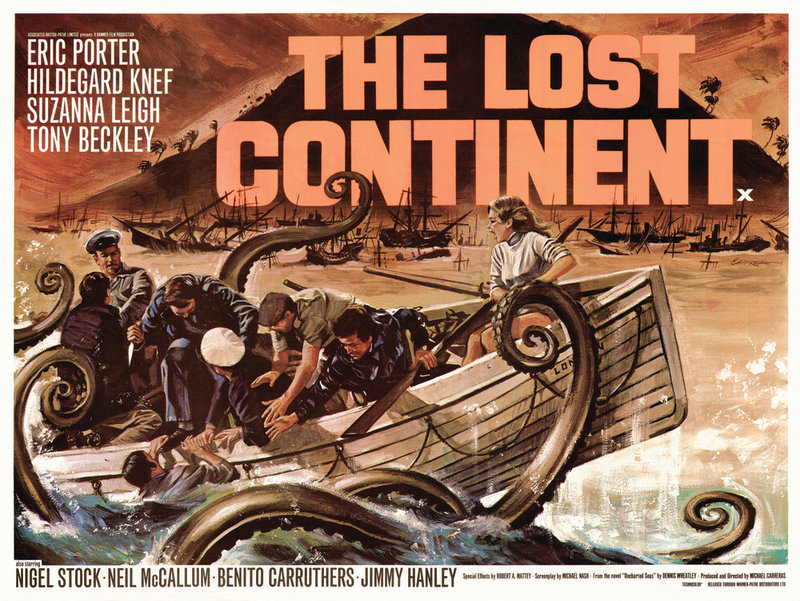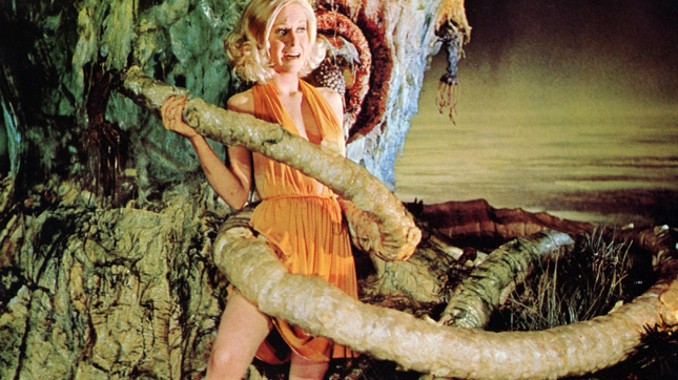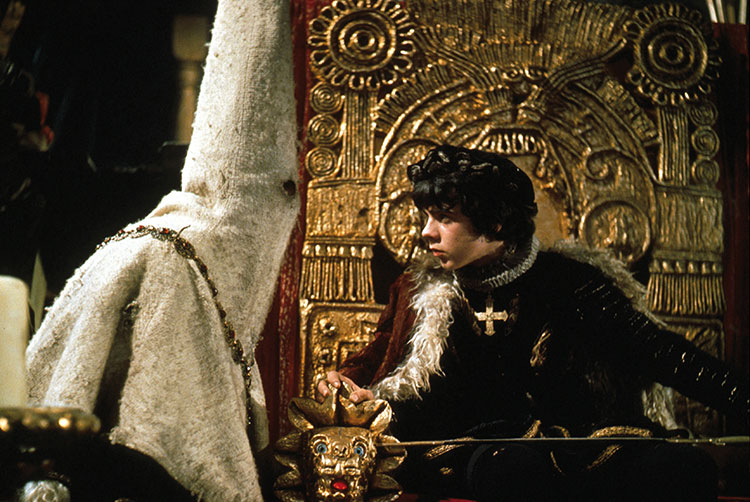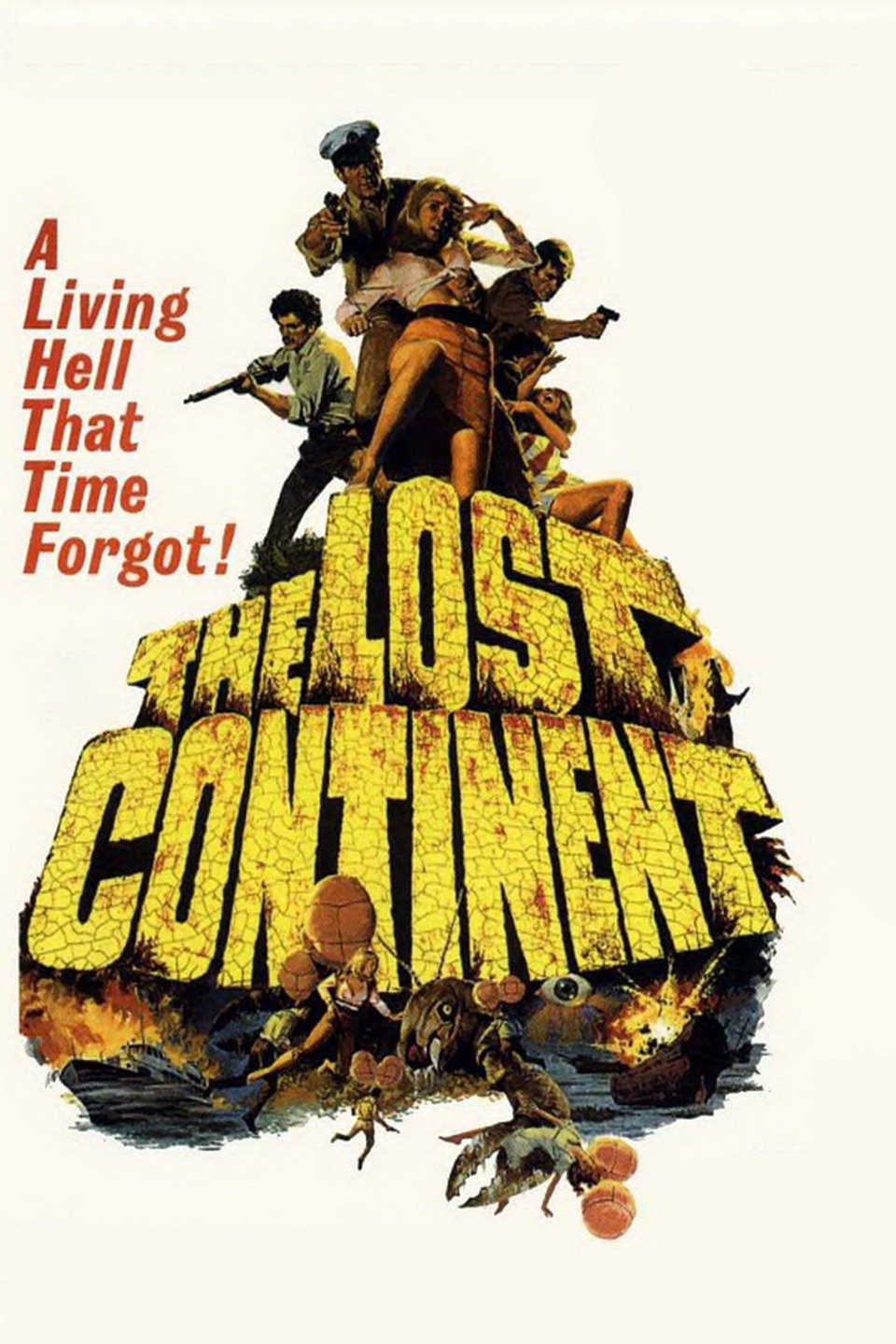Too Wide Sargasso Sea: Hammer’s The Lost Continent (1968)
Hammer Film Productions’ fantasy-adventure The Lost Continent is an adaptation of the works of William Hope Hodgson. Or it is to me, anyway. The credits say it’s based on the 1938 novel Uncharted Seas by Dennis Wheatley, but my eyes don’t lie: what Hammer put on screen is the nearest any movie has come to capturing the aura of Hodgson’s weird tales of the slimy terrors of the deep and the unknown horrors lurking in the Sargasso Sea.*
The Lost Continent arrived during the final phase of Hammer’s golden age. The company had moved out of its original studio at Bray and was now shooting at Pinewood and Elstree Studios. The feel of a unified family was starting to fray, and Hammer’s best in-house producers would soon depart. But producer Michael Carreras, son of studio head James Carreras, was still around and pushing Hammer to make larger-scale adventure films. Although Carreras was one of Hammer’s most prolific producers of horror movies — he produced Terence Fisher-directed classics like The Mummy, Dracula, and The Curse of the Werewolf — he never had any personal fondness for the Gothics. He saw lavish adventure and fantasy films like She (1965) and One Million Years B.C. (1966) as Hammer’s future. The Lost Continent was meant as an extension of the success of those movies, although it sometimes veered into horror.
Carreras was also an occasional director, and when The Lost Continent’s original director Leslie Norman (X the Unknown) fell sick early in production, Carreras stepped into the director’s chair. Carreras also wrote the screenplay under the pseudonym Michael Nash, the name of his gardener.
The movie follows the basic outline of Wheatley’s novel. The cargo ship Corita under the command of Captain Larsen (Eric Porter, later to star in Hammer’s excellent Hands of the Ripper) leaves the West African coast en route to Caracas. The crew and the passengers are a set up for what we’d today call a disaster movie, but at the time would’ve been compared to Grand Hotel or Stagecoach: disparate and desperate people pushed together through circumstance. Each passenger is running from something: Dr. Webster (Nigel Stock) and his daughter Unity (Suzanna Leigh) are getting away from the discovery of Webster’s sexual misconduct with his patients. Piano player and designated drunk Harry Tyler (Tony Beckley) has had gigs go bad. Eva Peters (Hildegard Knef) is in flight with stolen bearer bonds needed to ransom her son from a political hostage situation, and Ricaldi (Ben Carruthers) is the sleazy legal agent trying to steal the bonds back. Captain Larsen has his own secret: he’s transporting a cargo-hold of tubs of valuable Phosphor-B to Caracas. Phosphor-B explodes when it comes into contact with water, which was why placing it aboard a termite-ridden ship like the Corita was a capital idea.
Guess what happens? Complications with the Phosphor-B after Larsen purposely plows the Corita into a storm to save time causes a crew mutiny and everyone abandoning ship. The lifeboat with the passengers, the captain, and the loyal crew drift for days until they float into the mad world of the Sargasso Sea and its carnivorous seaweed. They also bump into the Corita ensnared among the other ships — getting them right back where they started from. They find themselves trapped in a dank, misty world of sea monsters and other terrors surrounding a rocky island. (This is as much of a “continent” as appears in The Lost Continent, and no one from the Corita ever sets foot on it.) There’s also a human danger among the graveyard of ships. The descendants of Spanish conquistadors marooned in the weeds hundreds of years ago are tormenting a peaceful population living on the island. The Spaniards aren’t any more hospitable toward the newcomers.
 Although it tries to slot into Hammer’s mid-‘60s adventure movie catalog, The Lost Continent isn’t exactly a rollicking good time. It’s grim and borders closer to horror than conventional Lost World stories. This is the “Hodgson Effect” digging in. The characters, almost all of them appalling, don’t raise spirits, and it takes forever for the story to arrive at the Sargasso Sea. The first sight of kelp and seaweed arrives halfway through the running time, and the titular “lost continent” takes even more time to show up. The movie isn’t boring, although there are sections with the characters that in retrospect are just filling space, and it’s redundant to have the passengers abandon the Corita only to go back to it fifteen minutes later. But it’s not a colorful high adventure like the trio of Edgar Rice Burroughs Lost World movies Amicus made in the 1970s.
Although it tries to slot into Hammer’s mid-‘60s adventure movie catalog, The Lost Continent isn’t exactly a rollicking good time. It’s grim and borders closer to horror than conventional Lost World stories. This is the “Hodgson Effect” digging in. The characters, almost all of them appalling, don’t raise spirits, and it takes forever for the story to arrive at the Sargasso Sea. The first sight of kelp and seaweed arrives halfway through the running time, and the titular “lost continent” takes even more time to show up. The movie isn’t boring, although there are sections with the characters that in retrospect are just filling space, and it’s redundant to have the passengers abandon the Corita only to go back to it fifteen minutes later. But it’s not a colorful high adventure like the trio of Edgar Rice Burroughs Lost World movies Amicus made in the 1970s.
The characters are what darkens The Lost Continent the most. This is a passel of unlikable folks of all types. It starts at the top with Captain Larsen, who deserves that mutiny for secretly carrying water-triggered explosives through a storm. Harry Tyler starts as a conventional funny drunk, but then becomes a violent drunk and later an even worse ex-drunk who makes everybody miserable. Once Unity Webster gets out from under the rule of her boorish, sexually unethical father, she changes into a rapacious sex prowler who seems unaware that the Sargasso Sea isn’t the place for this type of party. Eva Peters is the nearest the film has to a major sympathetic character, although the script delays revealing her backstory of why she has to reach Caracas. The bartender, Patrick (Jimmy Hanley), is the only person who isn’t either awful or drowning in morosity before disaster strikes.
This isn’t a knock on any of the performers, who are uniformly good. In fact, Suzanna Leigh as Unity Webster is kind of a blast. She looks like a standard Hammer “bland pretty girl,” but Leigh tears into the nasty side of Unity when she celebrates her father’s gory death and tries to shove a reformed alcoholic off the wagon just so he’ll party with her and sleep with her. It’s a surprising character and performance. Knef and Porter are both solid as the ostensible protagonists, Eva and Larsen, and thankfully the film doesn’t try to forge a romance between them. There’s no reason to like Captain Larsen, but Eric Porter has a steely presence that keeps viewers invested in him. Porter creates a sense of Larsen having more of an arc than exists on the page.
If you’re fine with The Lost Continent being bleaker than the average Saturday matinee adventure, you’ll find plenty of outright bizarre things to enjoy during the second half. The lighter-than-air balloons and giant footpads the Spaniards and the islanders wear to walk atop the seaweed are a zany creation right out of Jules Verne. The various monsters include a rock crab, a scorpion-thing, aggressive carnivorous vines, and a tentacled behemoth that leaves poor Unity covered in blood and green slime.
 The weirdest and most enjoyable part of the movie is the Spanish conquistadors. Inbred, fanatical, and malformed, the Spanish crew is ruled by the pompous youth El Supremo (Darryl Read, later a member of the protopunk band Crush Butler) and a Grand Inquisitor who wears a capriote, a type of peaked cap and mask that any U.S. viewer will instantly see as a Klan hood. El Supremo has disobedients thrown down a hatch to a man-eating plant that’s a disgusting toothy maw — a miniature Sarlacc but ickier.
The weirdest and most enjoyable part of the movie is the Spanish conquistadors. Inbred, fanatical, and malformed, the Spanish crew is ruled by the pompous youth El Supremo (Darryl Read, later a member of the protopunk band Crush Butler) and a Grand Inquisitor who wears a capriote, a type of peaked cap and mask that any U.S. viewer will instantly see as a Klan hood. El Supremo has disobedients thrown down a hatch to a man-eating plant that’s a disgusting toothy maw — a miniature Sarlacc but ickier.
(The Inquisitor was originally meant for Christopher Lee, but ended up played by his stunt double, Eddie Powell. Had Lee taken the part, the Inquisitor would certainly have had a larger role.)
During the scenes aboard the Spanish galleon, The Lost Continent starts to obtain levels of Hammer’s most atmospheric pictures, partially because it feels removed from the contemporary setting. Essentially, a demented Gothic pirate movie invaded the bleakest episode ever of The Love Boat. (The Hate Boat, I guess.) The Spaniards are also original to the movie script. In the novel, the villains are uncomfortably stereotypical “black savages” who live on a separate island and assault the white inhabitants of the first island. Changing the adversaries to cultish sixteenth-century Spaniards is more imaginative and avoids the uglier side of Wheatley’s monarchist British imperialism.
The soundtrack features songs performed by the Peddlers, a pop trio who charted a number of times in the UK, most notably a cover of “On a Clear Day You Can See Forever.” Their title song for The Lost Continent has a similar haunting groove with eerie Hammond organ. It’s surprisingly effective for what seems like a bad musical tactic for a killer seaweed movie. It fits the mood of the characters and the general otherworldly gloom. This was an era when movies could have theme songs that used the actual title, even something as fantastical and non-pop as The Lost Continent. Remember when the James Bond movies accepted the challenge of using The Man with Golden Gun as the title for a theme song? Today they won’t even use something as easy as Spectre as for a song title. Pop theme writers were braver souls in the ‘60s and ‘70s.
The special effects are hit and miss. The production went over schedule and over budget, and the studio cracked down hard on what was already a difficult shoot on a specially built water tank at Elstree Studios. This stinted some of the monster effects. Robert A. Mattey, the designer of the giant crab and sea scorpion that have a smackdown in the big monster moment, was certainly capable of doing amazing work: he created the squid for 20,000 Leagues Under the Sea and came out of retirement to build the shark models for Jaws. But with the time and money crunch on The Lost Continent, Mattey’s work ends up a touch comic. The first shots of the crab are nightmarish, but when the two mostly immobile creatures start clumsily bashing into each other, the fright factors falls away.
 But the work on ship models and the vistas of the Sargasso are truly spectacular, probably because they were part of pre-production work when the money was still flowing. The shots of the Corita steaming through dead ship hulks, or even just drifting on the open ocean, are intricately detailed and realistic for the period. The matte paintings and special effects art direction make the stagnant sea of rotting vessels from throughout history a freakish marvel. Art direction was always one of Hammer’s strongest qualities, and with a larger budget the results are often beautiful — in a gross, rot-and-slime kind of way, but that was the goal. Hodgson would’ve loved it.
But the work on ship models and the vistas of the Sargasso are truly spectacular, probably because they were part of pre-production work when the money was still flowing. The shots of the Corita steaming through dead ship hulks, or even just drifting on the open ocean, are intricately detailed and realistic for the period. The matte paintings and special effects art direction make the stagnant sea of rotting vessels from throughout history a freakish marvel. Art direction was always one of Hammer’s strongest qualities, and with a larger budget the results are often beautiful — in a gross, rot-and-slime kind of way, but that was the goal. Hodgson would’ve loved it.
Wheatley did not love it, complaining in his autobiography about the alterations made to the novel. He was probably assuaged by Hammer’s superlative version of his most famous book, The Devil Rides Out, released the same year. Hammer made one more Wheatley adaptation, To the Devil … A Daughter. This one angered Wheatley to the point he refused Hammer the rights to any more of his books. It didn’t matter, since To the Devil … A Daughter was the studio’s final horror film before ceasing production in 1979.
The Lost Continent was not a success when released to theaters. At a budget of over half a million pounds, Hammer took a big hit from it. After this and the similarly budgeted Moon Zero Two in 1969, the studio moved into narrower budgets for the 1970s. U.S. co-financing was disappearing and the brief era of the Hammer epics was over.
The Lost Continent was released in North America on DVD from Anchor Bay in 1999 as part of their Hammer Collection series. The disc is long out of production and expensive to find used. We haven’t had much luck with the Anchor Bay-licensed Hammer films re-emerging on either DVD or Blu-ray — The Devil Rides Out, Rasputin the Mad Monk, The Mummy’s Shroud, The Reptile, Plague of the Zombies. All of these films were co-financed with 20th Century Fox, so it must be Fox holding up new releases. I doubt when the ink dries on the Disney deal to purchase Fox that the Mouse House will move swiftly on getting these catalog titles out to fans. Yet another reason I gave in and got a region-free Blu-ray player.
*The best direct adaptation of William Hope Hodgson is the 1965 Japanese horror film Matango, based on Hodgson’s most famous story, “The Voice in the Night,” and made by the same creative team behind Godzilla and many other Japanese SF classics of the 1960s. Unfortunately, it was distributed in the U.S. for years under the silly title Attack of the Mushroom People and has therefore never gotten its due.
Ryan Harvey is one of the original bloggers for Black Gate, starting in 2008. He received the Writers of the Future Award for his short story “An Acolyte of Black Spires,” and his stories “The Sorrowless Thief” and “Stand at Dubun-Geb” are available in Black Gate online fiction. A further Ahn-Tarqa adventure, “Farewell to Tyrn”, is available as an e-book. His most recent publication, “The Invasion Will Be Alphabetized,” is now on sale in Stupendous Stories #19. Ryan lives in Costa Mesa, California where he works as a marketing writer. Occasionally, people ask him to talk about Edgar Rice Burroughs or Godzilla in interviews.

Another one of those movies (SEE ALSO: The Long Ships) that for years I only very vaguely remembered seeing on TV when visiting my grandparents in California sometime in the 1970s. The proto-Sarlaac has always haunted me.
After rewatching recently, I agree that the pacing is off. It’s the same complaint I had with the original movie version of Westworld, although Westworld is worse — in a 90 minute movie about a robot uprising at a cowboy theme park, I want the uprising to start somewhere before minute 75.
Did NOT know that Matango was based on a Hodgson story — I’ll have to track it down …
@Joe – Consider this article done as per your request!
Saw this one on the big screen when I was a kid. It was a very strange afternoon at the matinee!
@Ryan — Thanks!
(And as I think about it, there’s an excellent chance that for years what I “remembered” wasn’t so much this movie in particular as kind of a mélange of bits & bobs from this and the McClure Earth’s Core/Time Forgot films.)
Dana Gillespie’s’ cleavage haunted my adolescent dreams for some time after I saw this movie.
You take Dana, I’ll take Suzanna. I like saucy English blondes.